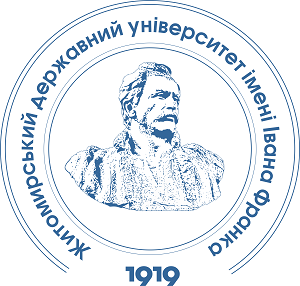DYNAMICS OF NON-HEME IRON CONTENT IN MYOCARDIUM AND HEME OXYGENASE ACTIVITY UNDER HYPERERGIC CONDITIONS
DOI:
https://doi.org/10.32782/naturaljournal.9.2024.1Keywords:
adrenaline, hemoxygenase, non-heme iron, myocardium, oxidative stressAbstract
Iron is the primary element involved in gas transport by blood and is a component of antioxidant enzymes within cells. Free iron, which is not bound to proteins or other molecules, can be chemically active and play different roles in cells and tissues. However, its high chemical activity can also lead to the formation of free radicals, which can damage cells and cause oxidative stress. In heart metabolism, where free radicals and oxidative stress can be harmful, control of free iron is very important. The body uses various mechanisms to control free iron levels, such as iron-binding proteins and antioxidants, to ensure the right balance and prevent possible damage. The dynamics of non-heme iron content in the myocardium were investigated under conditions of “adrenaline shock”. The amount of non-heme iron in the myocardium and blood plasma was determined at the beginning, middle, and end of the experiment. Simultaneously, the content of malonic dialdehyde, diene conjugates, superoxide dismutase, catalase, reduced glutathione, and hem oxygenase activity was also determined. By the end of the experiment, the content of non-heme iron in the myocardium had decreased, coinciding with an increase in the activity of hemoxygenase-1. Conversely, plasma levels of non-heme iron had increased, along with an elevation in oxidative stress markers such as malondialdehyde and diene conjugates in blood plasma. The antioxidant enzyme superoxide dismutase showed a decrease initially, followed by restoration towards the end of the experiment. A similar pattern was observed in the level of reduced glutathione. These findings suggest that under conditions of myocardial metabolic damage, hem oxygenase protection is activated to counteract excessive nonheme iron accumulation, thereby shielding the heart from oxidative stress development. However, in blood plasma, the level of active iron increases, leading to heightened oxidative stress and a decrease in antioxidant enzyme levels. Towards the conclusion of the experiment, the antioxidant blood system levels stabilize.
References
Aebi H. Oxygen radicals in biological systems. Methods. Enzymol. 1984. № 105 (1947). P. 121–126.
Ayala A., Muñoz M.F., Argüelles S. Lipid peroxidation: production, metabolism, and signaling mechanisms of malondialdehyde and 4-hydroxy-2-nonenal. Oxidative medicine and cellular longevity. 2014. 360438. https://doi.org/10.1155/2014/360438.
Babior B.M., Kipnes R.S. Oxidation of epinephrine by a cell-free system from human granulocytes. Blood. 1976. № 47 (3). p. 461–471.
Balla J., Vercellotti G.M., Jeney V., Yachie A., Varga Z., Eaton J.W., Balla G. Heme, heme oxygenase and ferritin in vascular endothelial cell injury. Molecular nutrition & food research. 2005. № 49 (11). p. 1030–1043. https://doi.org/10.1002/mnfr.200500076.
Bannister J.V., Calabrese L. Assays for superoxide dismutase. Methods of biochemical analysis. 1987. № 32. P. 279–312. https://doi.org/10.1002/9780470110539.ch5.
Beschasnyi S.P. CORM-2 affects level of malondialdehyde and expression of myocardial markers PTGS2, ANP, BNP, MVH7 under induced ferroptosis. Prirodničij alʹmanah. Serìâ: bìologìčnìnauki, 2022. № 32. P. 47–54. https://doi.org/10.32999/ksu2524-0838/2022-32-5.
Beschasnyi S.P., Hasiuk O.M. The carbon monoxide donor, topiramate, and blockers of aquaporine receptors decrease myocardial ischemia-reperfusion injiry. Fiziologichnyi Zhurnal. 2021. № 67 (5). p. 30–38. https://doi.org/10.15407/fz67.05.030.
Beschasnyi S.P., Hasiuk O.M. Carbon Monoxide and Their Donor (CORM-2) Change the Healing Rate of Skin Wound Healing in Mice Through Reduced Expression of Aquaporin-3. Fabad Journal of Pharmaceutical Sciences. 2023. № 48.1. p. 1–10. https://doi.org/10.55262/fabadeczacilik. 1095369.
Bettiol A., Galora S., Argento F.R., Fini E., Emmi G., Mattioli I., Bagni G., Fiorillo C., Becatti M. Erythrocyte oxidative stress and thrombosis. Expert reviews in molecular medicine. 2022. № 24, e31. https://doi.org/10.1017/erm.2022.25.
Blair I.A. Endogenous glutathione adducts. Current drug metabolism. 2006. № 7 (8). P. 853–872. https://doi.org/10.2174/138920006779010601.
Blair I.A. Analysis of endogenous glutathione-adducts and their metabolites. Biomedical chromatography: BMC. 2010. № 24 (1). P. 29–38. https://doi.org/10.1002/bmc.1374.
Bozza M.T., Jeney V. Pro-inflammatory Actions of Heme and Other Hemoglobin-Derived DAMPs. Frontiers in immunology. 2020. № 11. P. 1323. https://doi.org/10.3389/fimmu.2020.01323.
Chiabrando D., Vinchi F., Fiorito V., Mercurio S., Tolosano E. Heme in pathophysiology: a matter of scavenging, metabolism and trafficking across cell membranes. Frontiers in pharmacology. 2014. № 5. P. 61. https://doi.org/10.3389/fphar.2014.00061 [in English].
Draper H.H., Squires E.J., Mahmoodi H., Wu J., Agarwal S., Hadley M. A comparative evaluation of thiobarbituric acid methods for the determination of malondialdehyde in biological materials. Free radical biology & medicine. 1993. № 15 (4). P. 353–363. https://doi.org/10.1016/0891-5849(93)90035-s.
Duarte T.L., Neves J.V. Measurement of Tissue Non-Heme Iron Content using a Bathophenanthroline-Based Colorimetric Assay. Journal of visualized experiments: JoVE. 2022. 179. https://doi.org/10.3791/63469.
Fuhrmann D.C., Brüne B. A graphical journey through iron metabolism, microRNAs, and hypoxia in ferroptosis. Redox biology. 2022. № 54. 102365. https://doi.org/10.1016/j.redox.2022.102365.
Graça-Souza A.V., Arruda M.A., de Freitas M.S., Barja-Fidalgo C., Oliveira P.L. Neutrophil activation by heme: implications for inflammatory processes. Blood. 2022. № 99 (11). P. 4160–4165. https://doi.org/10.1182/blood.v99.11.4160.
Khan A.A., Quigley J.G. Control of intracellular heme levels: heme transporters and hemeoxygenases. Biochimica et biophysicaacta. 2011. № 1813 (5), p. 668–682. https://doi.org/10.1016/j.bbamcr.2011.01.008.
King R.F., Brown S.B. The mechanism of haem catabolism. A study of haem breakdown in spleen microsomal fraction and ina model system by 18O labelling and metal substitution. The Biochemical journal. 1978. № 174 (1). P. 103–109. https://doi.org/10.1042/bj1740103.
Kumar S., Bandyopadhyay U. Free heme toxicity and its detoxification systems in human. Toxicology letters. 2005. № 157 (3). P. 175–188. https://doi.org/10.1016/j.toxlet.2005.03.004 [in English].
Miguel L.I., Leonardo F.C., Torres L.S., Garcia F., Mendonça R., Ferreira W.A. Jr., Gotardo É.M.F., Fabris F.C.Z., Brito P.L., Costa F.F., Conran N. Heme induces significant neutrophil adhesion in vitro via an NFκB and reactive oxygen species-dependent pathway. Molecular and cellular biochemistry. 2021. № 476 (11). P. 3963–3974. https://doi.org/10.1007/s11010-021-04210-5.
Monteiro A.P., Pinheiro C.S., Luna-Gomes T., Alves L.R., Maya-Monteiro C.M., Porto B.N., Barja-Fidalgo C., Benjamim C.F., Peters-Golden M., Bandeira-Melo C., Bozza M.T., Canetti C. Leukotriene B4 mediates neutrophil migration induced by heme. Journal of immunology (Baltimore, Md.: 1950). 2011. № 186 (11). P. 6562–6567. https://doi.org/10.4049/jimmunol.1002400.
Müllebner A., Moldzio R., Redl H., Kozlov A.V., Duvigneau J.C. Heme Degradation by Heme Oxygenase Protects Mitochondria but Induces ER Stress via Formed Bilirubin. Biomolecules. 2015. № 5 (2). P. 679–701. https://doi.org/10.3390/biom5020679.
Pautler R.G. Mouse MRI: concepts and applications in physiology. Physiology (Bethesda, Md.). 2004. 19. P. 168–175. https://doi.org/10.1152/physiol.00016.2004.
Rother R.P., Bell L., Hillmen P., Gladwin M.T. The clinical sequelae of intravascular hemolysis and extracellular plasma hemoglobin: a novel mechanism of human disease. JAMA. 2015. № 293 (13). P. 1653–1662. https://doi.org/10.1001/jama.293.13.1653.
Santambrogio P., Biasiotto G., Sanvito F., Olivieri S., Arosio P., Levi S. Mitochondrial ferritin expression in adult mouse tissues. The journal of histochemistry and cytochemistry: official journal of the Histochemistry Society. 2007. № 55 (11). P. 1129–1137. https://doi.org/10.1369/jhc.7A7273.2007.
Sies H. Oxidative stress: a concept in redox biology and medicine. Redox biology. 2015. № 4. P. 180–183. https://doi.org/10.1016/j.redox.2015.01.002 [in English].
Sokolenko V.L., Sokolenko S.V. Parameters of lipid and oxidative-antioxidant status in persons aged 18-23 from radiation-contaminated areas under conditions of moderate physical activity. Physical Education of Students. 2020. № 24 (5). p. 293–303. https://doi.org/10.15561/20755279.2020.0506.
Stamenkovic A., Pierce G.N., Ravandi A. Phospholipid oxidation products in ferroptotic myocardial cell death. American journal of physiology. Heart and circulatory physiology. 2019. № 317 (1). P. H156–H163. https://doi.org/10.1152/ajpheart.00076.2019.
Todd G.L., Baroldi G., Pieper G.M., Clayton F.C., Eliot R.S. Experimental catecholamine-induced myocardial necrosis. I. Morphology, quantification and regional distribution of acute contraction band lesions. Journal of molecular and cellular cardiology. 1985. № 17 (4). P. 317–338. https://doi.org/10.1016/s0022-2828(85)80132-2.
Theil E.C. Ferritin: the protein nanocage and iron biomineral in health and in disease. Inorganic chemistry. 2013. № 52 (21). P. 12223–12233. https://doi.org/10.1021/ic400484n.
Tsikas D. Assessment of lipid peroxidation by measuring malondialdehyde (MDA) and relatives in biological samples: Analytical and biological challenges. Analytical biochemistry. 2017. № 524. P. 13–30. https://doi.org/10.1016/j.ab.2016.10.021.
Wagener F.A., Eggert A., Boerman O.C., Oyen W.J., Verhofstad A., Abraham N.G., Adema G., van Kooyk Y., de Witte T., Figdor C.G. Heme is a potent inducer of inflammation in mice and is counteracted by heme oxygenase. Blood. 2001. № 98 (6). P. 1802–1811. https://doi.org/10.1182/blood.v98.6.1802.






